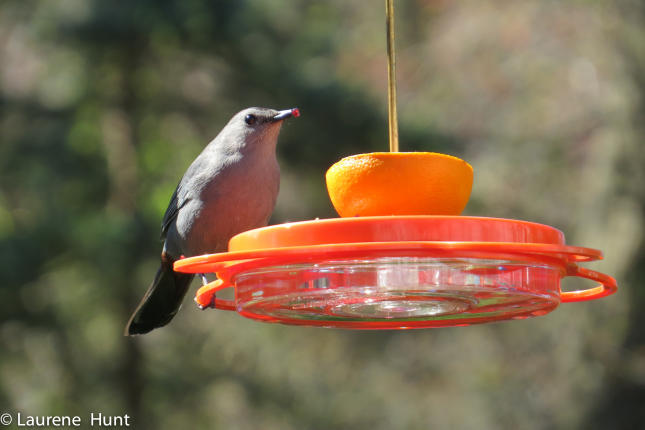
Have you seen this bird? It’s a Gray Catbird and just like the Baltimore Orioles, Rose-breasted Grosbeaks and Ruby-throated Hummingbirds I’ve been reporting on this week, catbirds are also returning to our yards and feeders!
I took this photo of a catbird visiting one of my Wild Birds Unlimited 3 in 1 Oriole Feeders. Notice that the catbird is eating grape jelly from the feeder. Just like orioles they will also come to feeders if nectar, orange halves, suet, mealworms and our WBU Bark Butter products are offered! During the summer months, both catbirds and orioles eat a lot of insects and primarily feed bugs to their young.
Of course, “Gray” Catbirds aren’t as flashy as the bright orange orioles, but what they lack in dazzling color they more than make up for with a cheerful personality! In suburban yards and parks, catbirds flit from tree to tree, bush to bush singing their boisterous repertoire of warbling whistles, gurgles, chirps and catlike mews. Like their relatives, the Northern Mockingbird, catbirds also mimic the songs of other birds and animals and weave them into their song, which can be a brief series of notes or a full-blown symphony! Catbird songs have been timed to last as long as 10 minutes while they sing to establish territories and attract mates. It’s the male that engages in these elaborate songs and the female who will sing back more briefly and quietly. It’s no surprise that females are attracted to the males with the longest songs because they have successfully survived the most seasons and learned the most notes!
Once the male wows his lady, they choose a piece of real estate (generally in the center of a dense bush or shrub) to set up nest building. The female builds the bulky, open nest cup from twigs, bark, mud, grasses, animal fur and pine needles. Often the male brings nesting material, but rarely helps build the nest. The female will lay and incubate 2-6 eggs and once hatched both parents will feed the young. The pair will raise 2-3 broods in a season.
Catbirds breed throughout much of the United States, although rarely in the most western states, and into southern Canada. Some birds are year-long residents along the Atlantic Coast south of New England and some winter along the Gulf Coast, into Mexico, the Caribbean and Central America.

